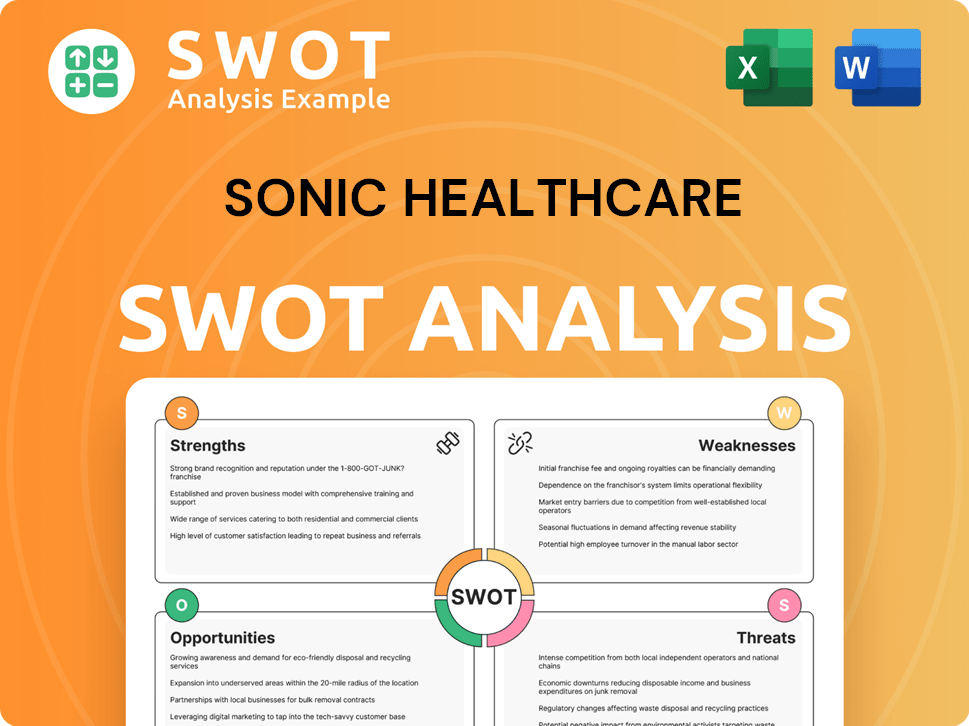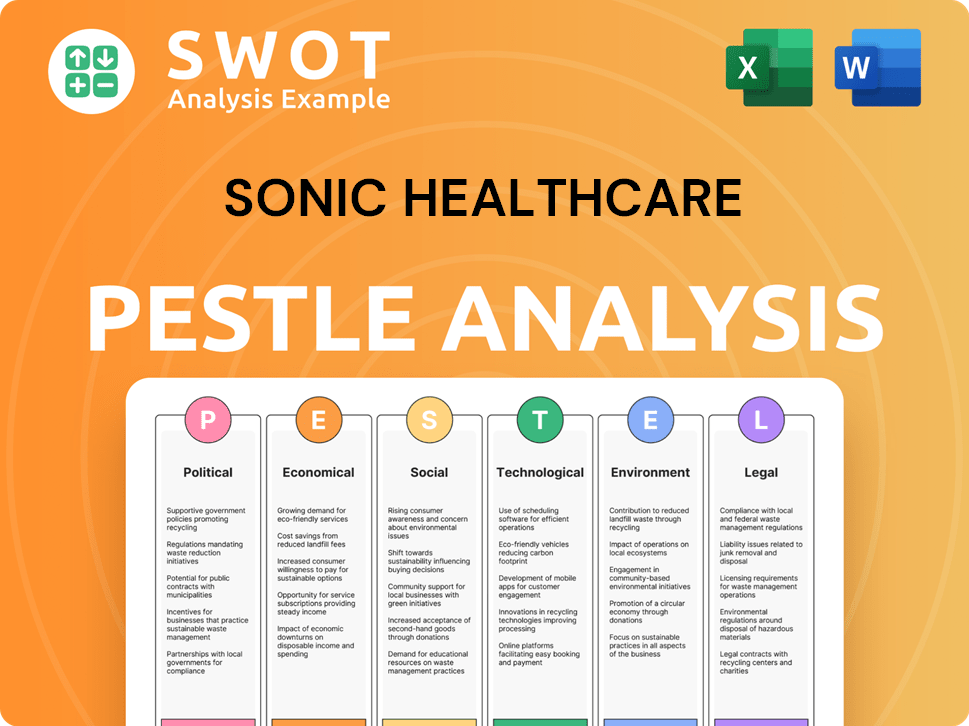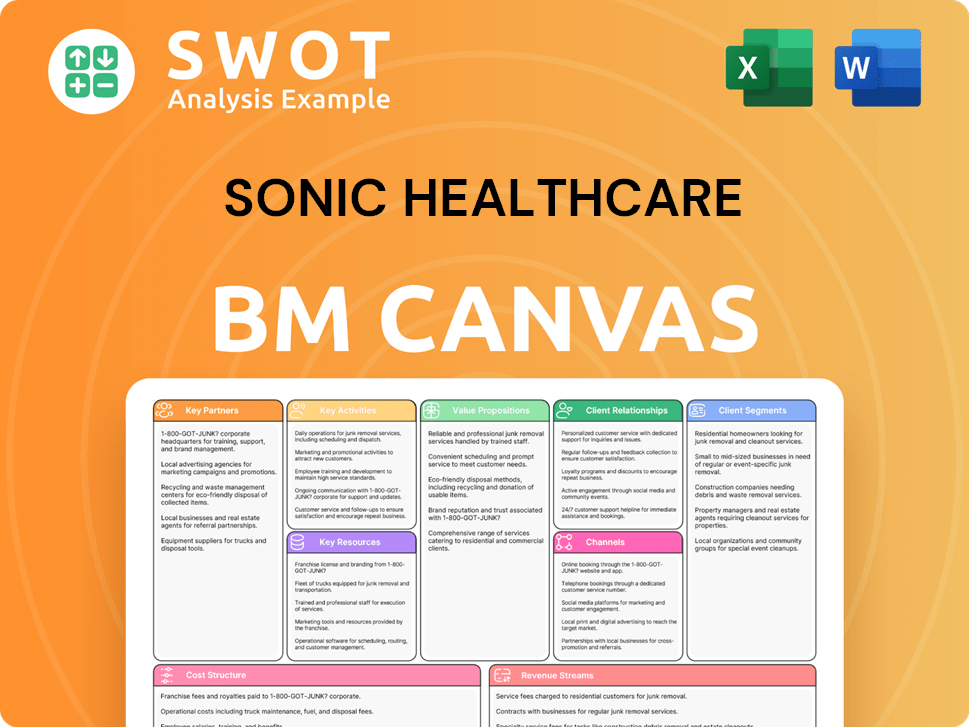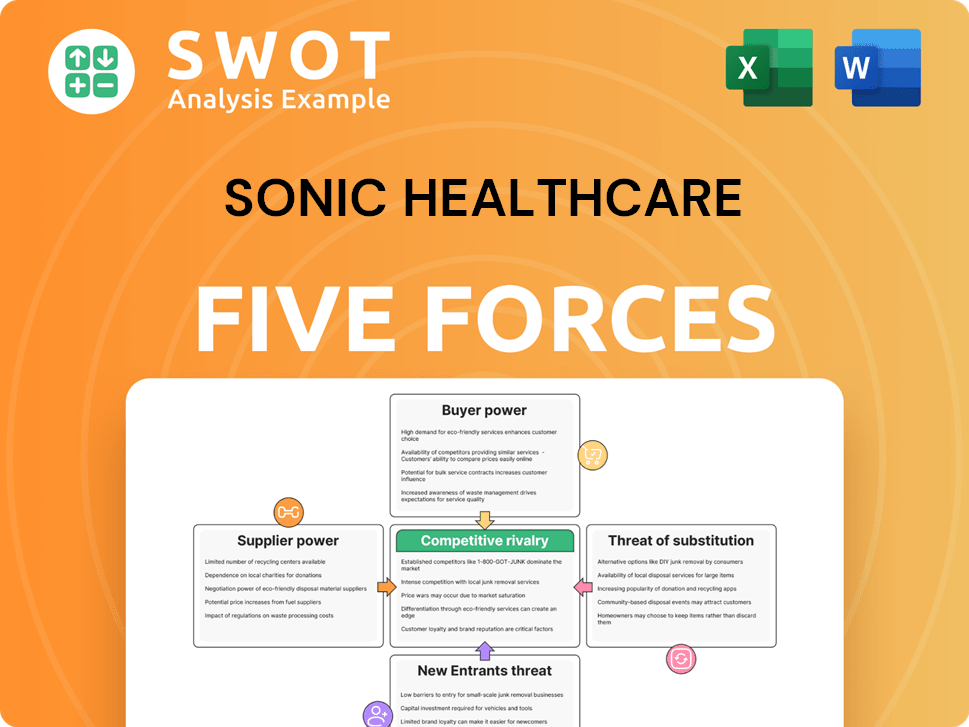Sonic Healthcare Bundle
Who Really Owns Sonic Healthcare?
Understanding the ownership of a company is paramount to grasping its strategic direction and future prospects. From its humble beginnings as a mining company, Sonic Healthcare has transformed into a global powerhouse in medical diagnostics. This evolution makes understanding Sonic Healthcare SWOT Analysis crucial for any investor or strategist.

This exploration into Sonic Healthcare's ownership structure reveals the key players shaping its trajectory, offering insights into its governance and market influence. Examining "Who owns Sonic Healthcare" provides a deeper understanding of this leading healthcare company. We'll delve into its history, from its Australian roots to its global presence, analyzing the major shareholders and the trends impacting its future. This analysis is essential for anyone interested in healthcare companies and the medical diagnostics sector.
Who Founded Sonic Healthcare?
The story of Sonic Healthcare begins long before its current status as a global leader in medical diagnostics. Its roots trace back to 1948, but the company's significant shift into healthcare didn't occur until the late 1980s.
The acquisition of Douglass Laboratories Pty Ltd in 1987 was a pivotal moment, marking its entry into the healthcare sector. This transition set the stage for the company's future, even though it initially continued to operate with a focus on mining.
A key player in shaping Sonic Healthcare's trajectory was Michael Boyd, whose investment and leadership were instrumental in the company's transformation and growth.
Founded as Gunnersen Nosworthy Ltd in 1948, the company's initial focus was not healthcare.
The acquisition of Douglass Laboratories Pty Ltd in 1987 marked the company's entry into the healthcare industry. This acquisition was a turning point.
In 1992, Michael Boyd, a young accountant, invested in Sonic, acquiring a substantial stake.
Boyd brought in new management, including Colin Goldschmidt, who later became CEO.
In 1995, the company officially changed its name to Sonic Healthcare Ltd.
The nine original pathologists of Douglass Laboratories also became investors in the company.
The early ownership structure of Sonic Healthcare reflects a pivotal shift towards medical diagnostics. The investment by Michael Boyd, coupled with the appointment of Colin Goldschmidt as CEO, signaled a new strategic direction. The company's focus on consolidating the pathology market proved successful. As of 2024, Sonic Healthcare has a market capitalization of approximately $16 billion AUD. The company has demonstrated consistent revenue growth, with revenue for the fiscal year 2024 reaching over $9.6 billion AUD. The company operates in multiple countries, including Australia, the United States, Germany, and the United Kingdom.
- Michael Boyd's early investment was crucial.
- The appointment of Colin Goldschmidt as CEO was strategic.
- The company's focus shifted towards medical diagnostics.
- The original pathologists of Douglass Laboratories were early investors.
Sonic Healthcare SWOT Analysis
- Complete SWOT Breakdown
- Fully Customizable
- Editable in Excel & Word
- Professional Formatting
- Investor-Ready Format

How Has Sonic Healthcare’s Ownership Changed Over Time?
The journey of Sonic Healthcare began in April 1987 when it was listed on the Australian Securities Exchange (ASX: SHL). Initially, the company was a mining entity, and specific market capitalization data from its initial listing is not readily available. However, by 1995, when the company officially became Sonic Healthcare Ltd, its share price was 55 cents. As of June 13, 2025, the market capitalization of Sonic Healthcare is approximately USD 12.89 billion.
The evolution of Sonic Healthcare's ownership structure has been significantly influenced by its strategic acquisitions and growth. Key milestones include the acquisition of the Schottdorf Group in Germany in 2004 and Clinical Pathology Laboratories (CPL) Inc. in the USA in 2005. These acquisitions expanded the company's global footprint and played a role in shaping its ownership profile as new capital was integrated to support these expansions.
| Ownership Category | Percentage | Shares Held |
|---|---|---|
| Institutional Investors (STU:SAB) (May 30, 2025) | 31.84% | |
| Individual Insiders | 1.13% | 5,415,411 |
| Private Companies | 3.86% | 18,514,798 |
| General Public | 54% | 259,147,170 |
As of May 30, 2025, institutional investors hold a substantial portion of Sonic Healthcare's shares. State Street Global Advisors, Inc. holds 7.38% (35,419,922 shares), BlackRock Group holds 6.13% (29,440,945 shares), and The Vanguard Group, Inc. holds 5.01% (24,058,158 shares). Individual insiders hold 1.13%, and private companies hold 3.86%. The general public remains the largest shareholder group, holding 54% of the shares. This ownership structure reflects the company's growth and its position as a major player in the global healthcare market.
Sonic Healthcare's ownership structure has evolved significantly since its listing on the ASX in 1987.
- Institutional investors hold a significant portion of the shares.
- The general public remains the largest shareholder group.
- Strategic acquisitions have played a key role in shaping the ownership profile.
- The company's market capitalization as of June 13, 2025, is USD 12.89 billion.
Sonic Healthcare PESTLE Analysis
- Covers All 6 PESTLE Categories
- No Research Needed – Save Hours of Work
- Built by Experts, Trusted by Consultants
- Instant Download, Ready to Use
- 100% Editable, Fully Customizable

Who Sits on Sonic Healthcare’s Board?
The current Board of Directors of Sonic Healthcare comprises a blend of expertise, including seven independent, non-executive directors and two executive directors: the Chief Executive Officer and the Chief Financial Officer. The composition reflects the company's focus on medical leadership, with a pathologist and three other medical practitioners on the board. As of November 19, 2024, the board reflects a commitment to gender diversity, with 44% female representation and 56% male.
Dr. Colin Goldschmidt, the CEO and Managing Director, has been in his role since January 1993. The company prioritizes shareholder communication, keeping them informed of significant developments. Shareholders have the right to vote on director appointments and can question the Board and external auditor at the Annual General Meeting (AGM). The voting structure typically follows a one-share-one-vote basis, with major changes affecting share ownership rights subject to shareholder approval. All resolutions at the November 19, 2024, AGM were passed, demonstrating strong shareholder support for the company's governance and strategic direction. You can learn more about the company's financial structure by reading Revenue Streams & Business Model of Sonic Healthcare.
| Board Member | Role | Details |
|---|---|---|
| Dr. Colin Goldschmidt | CEO and Managing Director | Appointed January 1993; Executive Director |
| Non-Executive Directors | Various | Includes a pathologist and three other medical practitioners |
| Gender Diversity | Representation | 44% Female, 56% Male (as of November 19, 2024) |
The Board of Directors at Sonic Healthcare is structured to blend medical expertise with corporate governance, ensuring a focus on both healthcare and shareholder value. Shareholders have significant influence through voting rights on director appointments and key decisions. The commitment to gender diversity and transparent communication highlights the company's dedication to inclusive and responsible governance.
- Diverse board composition with medical professionals.
- Shareholder voting rights on director appointments.
- Commitment to gender diversity on the board.
- Transparent communication with shareholders.
Sonic Healthcare Business Model Canvas
- Complete 9-Block Business Model Canvas
- Effortlessly Communicate Your Business Strategy
- Investor-Ready BMC Format
- 100% Editable and Customizable
- Clear and Structured Layout

What Recent Changes Have Shaped Sonic Healthcare’s Ownership Landscape?
In recent years, Sonic Healthcare has demonstrated consistent growth, as evidenced by its financial results. For the 2024 financial year, the company reported revenues of A$9.0 billion and a net profit of A$511 million. The company's strategic acquisitions have contributed significantly, adding approximately A$655 million in new annual revenue during the year.
The company's ownership structure has remained relatively stable, with no substantial share dilution for shareholders in the past year. The company's financial health is robust, with a strong balance sheet. Sonic Healthcare's commitment to shareholders is further reflected in its dividend strategy, with total dividends for the 2024 financial year reaching A$1.06 per share, marking a 2% increase from FY2023.
The Board of Directors has seen recent changes, including the appointment of Ms. Nicola Wakefield Evans AM as a Non-executive Director, effective February 10, 2025. Additionally, Professor Suzanne Crowe AO and Professor Christine Bennett AO were appointed to key committees during 2024. The company's focus aligns with industry trends towards preventative medicine and genetics-based personalized medicine, driving market share growth.
Sonic Healthcare's 2024 revenue reached A$9.0 billion, with a net profit of A$511 million. The base business (non-COVID related) revenue grew strongly at 16%, including 6% organic growth. Acquisitions added about A$655 million in new annual revenue.
There was no meaningful share dilution for shareholders in the past year. Total dividends for 2024 were A$1.06 per share, up 2% from the previous year. The company maintains a strong balance sheet, allowing it to pursue further growth opportunities.
Ms. Nicola Wakefield Evans AM was appointed as a Non-executive Director, effective February 10, 2025. Professor Suzanne Crowe AO and Professor Christine Bennett AO were also appointed to key committees during 2024. These changes reflect the company's ongoing strategic evolution.
Sonic Healthcare's focus on preventative medicine and genetics-based personalized medicine aligns with current industry trends. This strategic direction supports market share growth. The company's medical leadership culture is also a key driver.
Sonic Healthcare Porter's Five Forces Analysis
- Covers All 5 Competitive Forces in Detail
- Structured for Consultants, Students, and Founders
- 100% Editable in Microsoft Word & Excel
- Instant Digital Download – Use Immediately
- Compatible with Mac & PC – Fully Unlocked

Related Blogs
- What are Mission Vision & Core Values of Sonic Healthcare Company?
- What is Competitive Landscape of Sonic Healthcare Company?
- What is Growth Strategy and Future Prospects of Sonic Healthcare Company?
- How Does Sonic Healthcare Company Work?
- What is Sales and Marketing Strategy of Sonic Healthcare Company?
- What is Brief History of Sonic Healthcare Company?
- What is Customer Demographics and Target Market of Sonic Healthcare Company?
Disclaimer
All information, articles, and product details provided on this website are for general informational and educational purposes only. We do not claim any ownership over, nor do we intend to infringe upon, any trademarks, copyrights, logos, brand names, or other intellectual property mentioned or depicted on this site. Such intellectual property remains the property of its respective owners, and any references here are made solely for identification or informational purposes, without implying any affiliation, endorsement, or partnership.
We make no representations or warranties, express or implied, regarding the accuracy, completeness, or suitability of any content or products presented. Nothing on this website should be construed as legal, tax, investment, financial, medical, or other professional advice. In addition, no part of this site—including articles or product references—constitutes a solicitation, recommendation, endorsement, advertisement, or offer to buy or sell any securities, franchises, or other financial instruments, particularly in jurisdictions where such activity would be unlawful.
All content is of a general nature and may not address the specific circumstances of any individual or entity. It is not a substitute for professional advice or services. Any actions you take based on the information provided here are strictly at your own risk. You accept full responsibility for any decisions or outcomes arising from your use of this website and agree to release us from any liability in connection with your use of, or reliance upon, the content or products found herein.